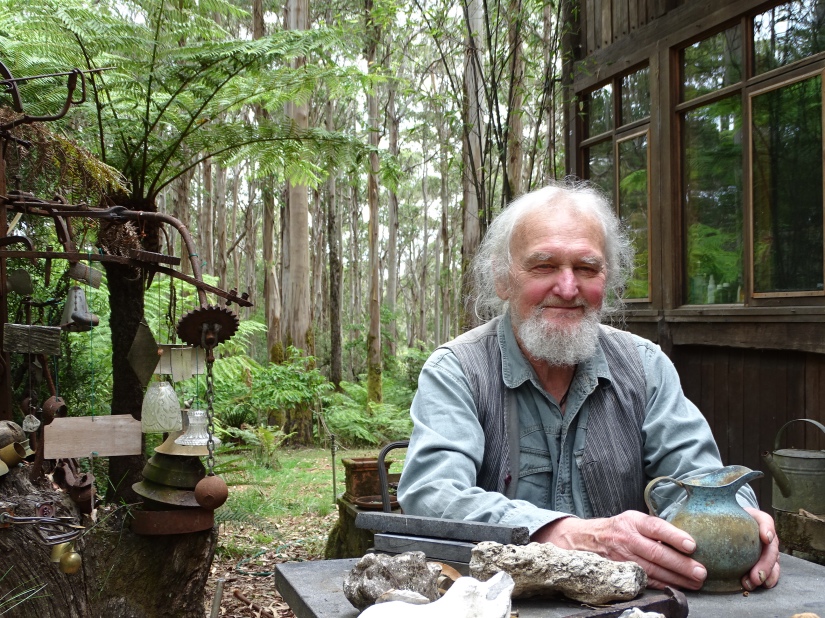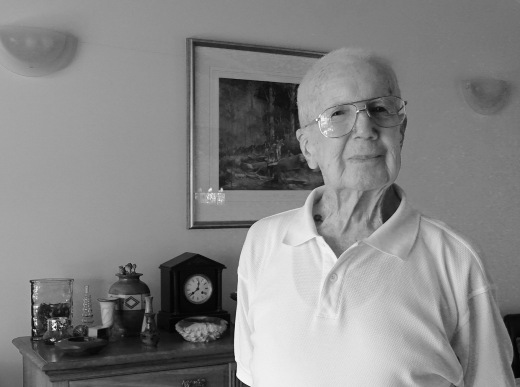Bryan Poynton (b. 1939-2020)
Artisanal woodworker, engineering patternmaker, artist, poet
Apprenticed at the International Harvester Company, Geelong, mid-1950s
I use my sense of judgment, my own sense of what I call my own personal aesthetic, that I’ve built up over the years, to judge what I do, by whether or not it can be altered to become better, ultimately have to come to a stage where you think, “yeah that’s alright. … What I see in something has proper proportion and balance and some sort of grace.

I was always doing something other than patternmaking but it was all still woodwork, what I thought was creative, necessary to my sanity.
Interviewer: In that sense was patternmaking never really enough?
In that sense that’s correct. It was never really enough. If I only was a patternmaker I would be really frustrated, because of my various interests. I suppose I’d be frustrated if I couldn’t do anything else.
Interviewer: What was restrictive about patternmaking?
Um, only the creative part, and I was totally easy about that aspect of it, and I wasn’t complaining, because I wasn’t being creative one during the process of making a pattern. I was always totally locked into doing the best I could to make that object. … I mean, I could no more just be a violin maker, or just a furniture maker, or just a woodturner, because I’m interested in so many different aspects of this.”
***
On the importance of looking after your sharpening stone

Your first tool, if you like, that you should buy, is at least one sharpening stone, or a couple of them a different grades, and then, having bought the best stone you can afford, You don’t just leave it ticking around in a box or amongst tools, like most carpenters, if they have a toolbox with a sharpening stone it’s always on the bottom and everything’s on top of it … My theory is you have to you have to really enjoy the act of sharpening, it’s such a fundamental thing. So you get a good stone and you make a box for it. I can show you a lovely box made from one here. A lot of people these days, they think you can go and buy a tool at a shop somewhere, and bring it home and start using it, and it’s okay sometimes for general rough carpentry, but patternmakers, you know, they pride themselves on having razor sharp tools. That’s why you would never loan a chisel to somebody else in the shop because their sharpening stone would be worn a little bit and when they tried to rub it on there you’ll get a different wear pattern, and so it’s important to always use your own stone and sharpen your tools and your plane blades and I used to spend hours doing that.
***
All I wanted to do was surf, and I’ve surfed all my life, and it’s only in the last three years that my knees are a bit rubbish and I can’t stand up quickly enough. … First of all it was body surfing of course, when we first went to Wye River. … In later years after I’d been at school, we still had a connection with Wye River. … I would go [to Separation Creek] all the weekends that I could get away. Even when I was an apprentice, I would hitchhike down on a Friday night, … and I’d surf all weekend, and then get a lift back to Geelong. So I gradually became better at surfing and I was eventually able to buy a surfboard. I surfed for years and years of course without any wetsuit, or leg ropes that they have now. … But eventually, I think it was 1956, when the Hawaiians and some Americans came into Sydney with little boards and there was a sort of revolution in surfing, because up to then, the Surf Clubs that existed all used long boards, one of which I had … they were 16 feet long, very difficult to ride, very narrow, and I did build one at one stage. … But then I saved up and I bought my first Balsawood board, probably in about 1960.
***
I had already been doing woodwork things, y’know, since I was about six or seven. […] Saturday afternoon I would sneak out to the Eastern Gardens which really only about a mile away from our house and – with a little saw of my father’s – and I’d go around until I found a little Cypress tree with nice curved branches on it and I’d make sure that the caretaker or the Ranger wasn’t around anywhere, and I’d saw off one of these little branches, and I’d take it home, and I’d used my father’s meagre collection of tools, like a little plane and a spoke-shave. I’d shape these bows, and then I’d sneak around the back lanes, and find any paling fences that were a bit loose, because, you know, in those days all the palings weren’t sawn, they were split, in the bush, and I’d split them down again, and make little squares, and then I plane them with a little plane, make round arrows. And then I would go to the local market where they sold chickens and pigs and turkeys, and all those things, and I pestered the blokes to give me some turkey feathers …
And so I’d glue those on to the shafts and then as a result of the War and my uncles coming home, there were a few 303 bullets lying around, so probably very dangerously I’d take the tops off those, and get rid of the powder, but I just had the pointy bit and I’d shaved down the end of the arrow and glue those on. So I had my bow and arrow and, the ones that I made, some used to fire a lot better and faster and longer shots than my other friends’ in the little gang that we had. They could afford to go and buy a bow and arrow from the sports store.
I was under nine when I was doing that sort of thing when I ran out of those arrowheads I contrived to get one of my father’s soldering irons and I’d poke it in the ground and leave a little hollow shape of the soldering iron, and then I’d suspend, with a box of wood and bricks, suspend the arrow inside the hole with a couple of little nicks in it and then I’d light a fire and melt some lead, can’t remember where I got the lead from, probably a few sinkers, and then I’d pour the lead around the arrow as soon as it set or put it in water. So they’re the sort of things I used to get up to at that age.
You can listen to Bryan Poynton’s interview here on the National Library’s digital collection item (timed summary also available).

